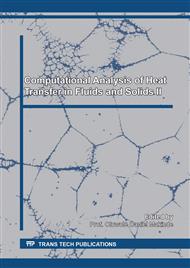[1]
D.Q Kern, A.D. Kraus, Extended Surface Heat Transfer, McGrawHill, New York, (1972).
Google Scholar
[2]
A.D. Kraus, A. Aziz, J. Welty, Extended Surface Heat Transfer, John Wiley and Sons, New York, (2001).
Google Scholar
[3]
P. Kanti Roy, A. Mallick, H. Mondal, P. Sibanda, A Modified Decomposition Solution of Triangular Moving Fin with Multiple Variable Thermal Properties, Arabian J Science and Engineering, 43(30): 14851497, (2017).
DOI: 10.1007/s13369-017-2983-3
Google Scholar
[4]
A.S. Dongonchi, D.D. Ganji, Convectionradiation heat transfer study of moving fin with temperaturedependent thermal conductivity, heat transfer coefficient and heat generation, Applied Thermal Eng. 103: 705712, (2016).
DOI: 10.1016/j.applthermaleng.2016.04.121
Google Scholar
[5]
M. Turkyilmazoglu, Heat transfer from moving exponential fins exposed to heat generation, Int J Heat and Mass Transfer, 116: 346351, (2018).
DOI: 10.1016/j.ijheatmasstransfer.2017.08.091
Google Scholar
[6]
M. Turkyilmazoglu, Efficiency of the longitudinal fins of trapezoidal profile in motion, Heat Transfer, 139(9): 4 pages, (2017).
DOI: 10.1115/1.4036328
Google Scholar
[7]
R.K. Singla, R. Das, Application of decomposition solution and inverse prediction of parameters in a moving fin, Energy Conversion and Management, 84: 268281, (2014).
DOI: 10.1016/j.enconman.2014.04.045
Google Scholar
[8]
Y.S. Sun, J. Ma, B.W. Li, Spectral collocation method for convectiveradiative transfer of a moving rod with variable thermal conductivity, Int J Thermal Sciences 90: 187196, (2015).
DOI: 10.1016/j.ijthermalsci.2014.12.019
Google Scholar
[9]
Y.S. Sun, J.L. Xu, Thermal performance of continuously moving radiativeconvective fin of complex crosssection with multiple nonlinearities, Int Comm Heat and Mass Transfer, 63: 2334, (2015).
DOI: 10.1016/j.icheatmasstransfer.2015.01.011
Google Scholar
[10]
J. Ma, Y. Sun, B. Li, Simulation of combined conductive, convective and radiative heat transfer in moving irregular porous fins by spectral element method, Int J Thermal Sciences, 118: 475487, (2017).
DOI: 10.1016/j.ijthermalsci.2017.05.008
Google Scholar
[11]
S.A. AlSanea, Mixed convection heat transfer along a continuously moving heated vertical plate with suction or injection, Heat Mass Transfer, 47(67): 14451465, (2004).
DOI: 10.1016/j.ijheatmasstransfer.2003.09.016
Google Scholar
[12]
P. Razelos, X. Kakatsios, Optimum dimensions of convectingradiating fins: Part I longitudinal fins, Applied Thermal Engineering 20: 11611192, (2000).
DOI: 10.1016/s1359-4311(99)00089-7
Google Scholar
[13]
A. Aziz, F. Khani, Convectionradiation from a continuously moving fin of a variable thermal conductivity, Franklin Institute, 34: 640651, (2011).
DOI: 10.1016/j.jfranklin.2011.01.008
Google Scholar
[14]
AM. Torabi, Q. Zhang, Analytical solution for evaluating the thermal performance and efficiency of convectiveradiative straight fins with various profiles and considering all nonlinearities, Energy Conversion and Management 66: 199210, (2013).
DOI: 10.1016/j.enconman.2012.10.015
Google Scholar
[15]
Y. Sun, J. Ma, B. Li, Z. Guo, Predication of nonlinear heat transfer in a convectiveradiative fin with temperaturedependent properties by the collocation spectral method, Numerical Heat Transfer Part B, 69(1): 6883, (2016).
DOI: 10.1080/10407782.2015.1081043
Google Scholar
[16]
B. Kundu, S. Wongwises, A decomposition analysis on convectiveradiating rectangular plate fins for variable thermal conductivity and heat transfer coefficient, Franklin Institute, 349: 966984, (2012).
DOI: 10.1016/j.jfranklin.2011.12.002
Google Scholar
[17]
A. Aziz, O.D. Makinde, Heat transfer and entropy generation in a twodimensional orthotropic convection pin fin, International J. of Exergy, 7(5), 579592, (2010).
DOI: 10.1504/ijex.2010.034930
Google Scholar
[18]
M.G. Mhlongo, R.J. Moitsheki, O.D. Makinde, Transient response of longitudinal rectangular fins to step change in base temperature and in base heat flow conditions, International J. of Heat and Mass Transfer, 57, 117125, (2013).
DOI: 10.1016/j.ijheatmasstransfer.2012.10.012
Google Scholar
[19]
J.K Zhou, Differential transformation and its application for electrical circuits, Huazhong University Press, Wuhan China, (1986).
Google Scholar
[20]
M. Torabi, H. Yaghoobi, A. Aziz, Analytical solution for convectiveradiative continuously moving fin with temperaturedependent thermal conductivity, Int J Thermophysics, 33: 924941, (2012).
DOI: 10.1007/s10765-012-1179-z
Google Scholar
[21]
A. Moradi, R. Rafiee, Analytical solution to convectionradiation of a continuously moving fin with temperaturedependent thermal conductivity, Thermal Science, 17(4): 10491060, (2013).
DOI: 10.2298/tsci110425005m
Google Scholar
[22]
P.L. Ndlovu, R.J. Moitsheki, Application of the twodimensional differential transform method to heat conduction problem for heat transfer in longitudinal rectangular and convex parabolic fins, Comm Nonlinear Science and Numerical Simulation, 18: 26892698, (2013).
DOI: 10.1016/j.cnsns.2013.02.019
Google Scholar
[23]
S. Mosayebidorcheh, M. RahimiGorji, D.D Ganji, T. Moayebidorcheh, O. Pourmehran, M. Biglarian, Transient thermal behavior of radial fins of rectangular, triangular and hyperbolic profiles with temperaturedependent properties using DTMFDM, Central South University, 24(3): 675682, (2017).
DOI: 10.1007/s11771-017-3468-y
Google Scholar
[24]
A. Fallo, R.J. Moitsheki, O.D. Makinde, Analysis of heat transfer in a cylindrical spine fin with variable thermal properties, Defect and Diffusion Forum, 387, 1022, (2018).
DOI: 10.4028/www.scientific.net/ddf.387.10
Google Scholar
[25]
M. Hatami, K. Hosseinzadeh, D.D. Ganji, M.T. Behnamfar, Numerical study of MHD twophase Couette flow analysis for fluidparticle suspension between moving parallel plates, Taiwan Institute of Chemical Engineers, 45(5): 22382245, (2014).
DOI: 10.1016/j.jtice.2014.05.018
Google Scholar
[26]
B. Kundu, K. Lee, A proper analytical analysis of annular step porous fins for determining maximum heat transfer, Energy Conversion and Management, 110: 469480, (2016).
DOI: 10.1016/j.enconman.2015.09.037
Google Scholar
[27]
P.L. Ndlovu, R.J. Moitsheki, Predicting the Temperature Distribution in Longitudinal Fins of Various Profiles with Power Law Thermal Properties Using the Variational Iteration Method, Defect and Diffusion Forum, 387: 403416, (2018).
DOI: 10.4028/www.scientific.net/ddf.387.403
Google Scholar
[28]
H.C. Ünal, An analytical study of boiling heat transfer from a fin, Int J Heat and Mass Transfer 31: 14831496, (1988).
Google Scholar
[29]
F. Kangalgil, F. Ayaz, Solitary wave solutions for the KdV and mKdV equations by differential transform method, Chaos, Solitons and Fractals, 41(1): 464472, (2009).
DOI: 10.1016/j.chaos.2008.02.009
Google Scholar
[30]
F. Ayaz, On the twodimensional differential transform method, Computational and Applied Mathematics, 143: 361374, (2003).
Google Scholar


